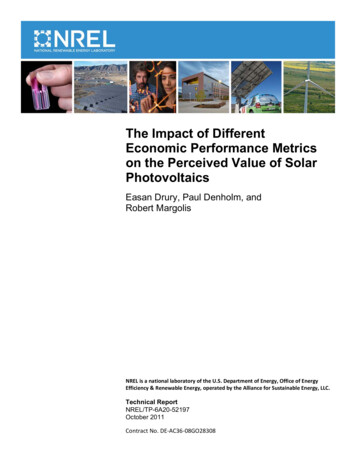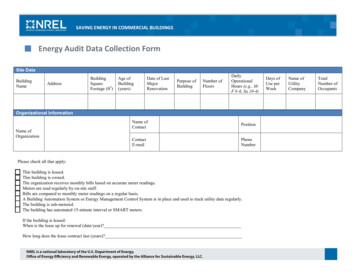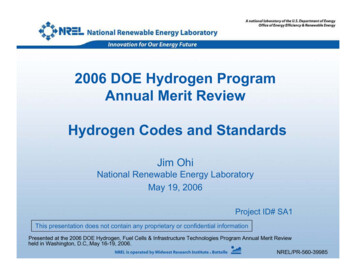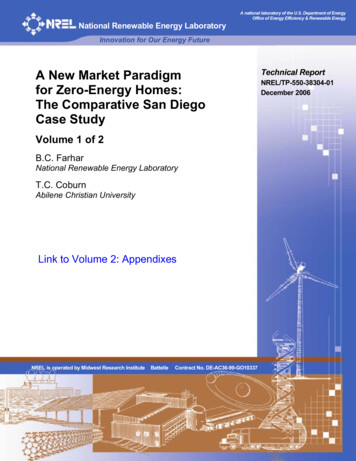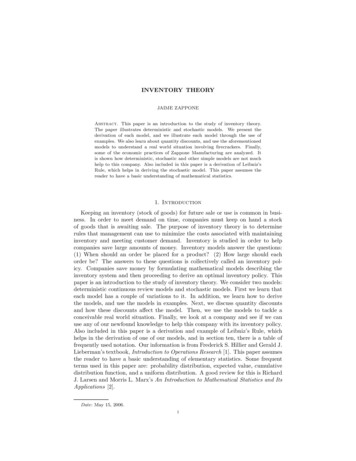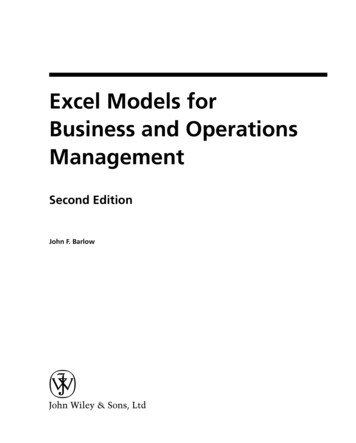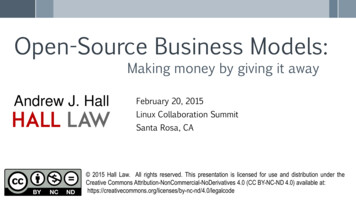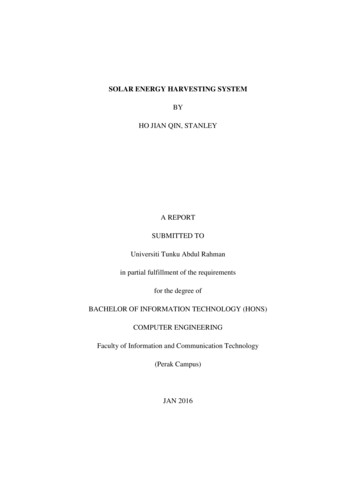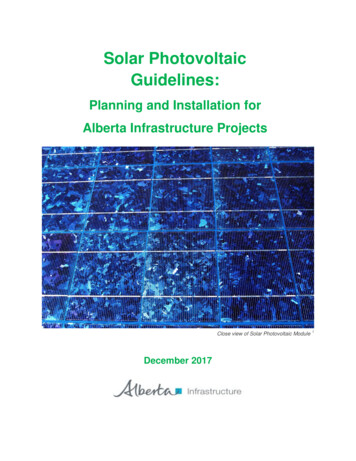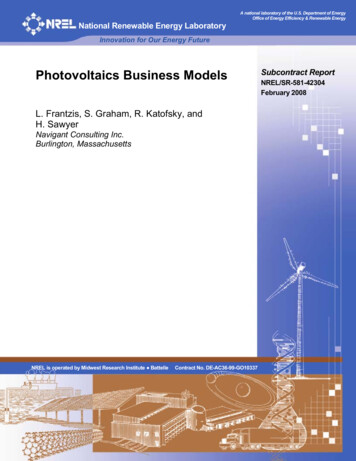
Transcription
A national laboratory of the U.S. Department of EnergyOffice of Energy Efficiency & Renewable EnergyNational Renewable Energy LaboratoryInnovation for Our Energy FuturePhotovoltaics Business ModelsL. Frantzis, S. Graham, R. Katofsky, andH. SawyerNavigant Consulting Inc.Burlington, MassachusettsNREL is operated by Midwest Research Institute BattelleContract No. DE-AC36-99-GO10337Subcontract ReportNREL/SR-581-42304February 2008
Photovoltaics Business ModelsL. Frantzis, S. Graham, R. Katofsky, andH. SawyerNavigant Consulting Inc.Burlington, MassachusettsNREL Technical Monitor: Robert MargolisPrepared under Subcontract No. KACX-4-44451-08National Renewable Energy Laboratory1617 Cole Boulevard, Golden, Colorado 80401-3393303-275-3000 www.nrel.govOperated for the U.S. Department of EnergyOffice of Energy Efficiency and Renewable Energyby Midwest Research Institute BattelleContract No. DE-AC36-99-GO10337Subcontract ReportNREL/SR-581-42304February 2008
NOTICEThis report was prepared as an account of work sponsored by an agency of the United States government.Neither the United States government nor any agency thereof, nor any of their employees, makes anywarranty, express or implied, or assumes any legal liability or responsibility for the accuracy, completeness, orusefulness of any information, apparatus, product, or process disclosed, or represents that its use would notinfringe privately owned rights. Reference herein to any specific commercial product, process, or service bytrade name, trademark, manufacturer, or otherwise does not necessarily constitute or imply its endorsement,recommendation, or favoring by the United States government or any agency thereof. The views andopinions of authors expressed herein do not necessarily state or reflect those of the United Statesgovernment or any agency thereof.Available electronically at http://www.osti.gov/bridgeAvailable for a processing fee to U.S. Department of Energyand its contractors, in paper, from:U.S. Department of EnergyOffice of Scientific and Technical InformationP.O. Box 62Oak Ridge, TN 37831-0062phone: 865.576.8401fax: 865.576.5728email: mailto:reports@adonis.osti.govAvailable for sale to the public, in paper, from:U.S. Department of CommerceNational Technical Information Service5285 Port Royal RoadSpringfield, VA 22161phone: 800.553.6847fax: 703.605.6900email: orders@ntis.fedworld.govonline ordering: http://www.ntis.gov/ordering.htmThis publication received minimal editorial review at NRELPrinted on paper containing at least 50% wastepaper, including 20% postconsumer waste
PrefaceNow is the time to plan for the integration of significant quantities of distributedrenewable energy into the electricity grid. Concerns about climate change, the adoptionof state-level renewable portfolio standards and incentives, and accelerated costreductions are driving steep growth in U.S. renewable energy technologies. The numberof distributed solar photovoltaic (PV) installations, in particular, is growing rapidly. Asdistributed PV and other renewable energy technologies mature, they can provide asignificant share of our nation’s electricity demand. However, as their market sharegrows, concerns about potential impacts on the stability and operation of the electricitygrid may create barriers to their future expansion.To facilitate more extensive adoption of renewable distributed electric generation, theU.S. Department of Energy launched the Renewable Systems Interconnection (RSI) studyduring the spring of 2007. This study addresses the technical and analytical challengesthat must be addressed to enable high penetration levels of distributed renewable energytechnologies. Because integration-related issues at the distribution system are likely toemerge first for PV technology, the RSI study focuses on this area. A key goal of the RSIstudy is to identify the research and development needed to build the foundation for ahigh-penetration renewable energy future while enhancing the operation of the electricitygrid.The RSI study consists of 15 reports that address a variety of issues related to distributedsystems technology development; advanced distribution systems integration; systemlevel tests and demonstrations; technical and market analysis; resource assessment; andcodes, standards, and regulatory implementation. The RSI reports are: Renewable Systems Interconnection: Executive Summary Distributed Photovoltaic Systems Design and Technology Requirements Advanced Grid Planning and Operation Utility Models, Analysis, and Simulation Tools Cyber Security Analysis Power System Planning: Emerging Practices Suitable for Evaluating the Impactof High-Penetration Photovoltaics Distribution System Voltage Performance Analysis for High-PenetrationPhotovoltaics Enhanced Reliability of Photovoltaic Systems with Energy Storage and Controls Transmission System Performance Analysis for High-Penetration Photovoltaics Solar Resource Assessment Test and Demonstration Program Definition Photovoltaics Value Analysisiii
Photovoltaics Business Models Production Cost Modeling for High Levels of Photovoltaic Penetration Rooftop Photovoltaics Market Penetration Scenarios.Addressing grid-integration issues is a necessary prerequisite for the long-term viability ofthe distributed renewable energy industry, in general, and the distributed PV industry, inparticular. The RSI study is one step on this path. The Department of Energy is alsoworking with stakeholders to develop a research and development plan aimed at makingthis vision a reality.iv
AcknowledgmentsThe authors would like to thank the Department of Energy (DOE) and the NationalRenewable Energy Laboratory (NREL) for supporting our work on this topic and theindustry experts who provided input including Robert Margolis, Peter H. Kobos, DanRastler, and Mark Bolinger. We would also like to thank reviewers at all of thecompanies who took time to review the case studies and examples presented in thisdocument, including staff from (in alphabetical order): Arizona Public Service, AustinEnergy, Borrego Solar, NSTAR, Old Country Roofing, SDG&E, the SacramentoMunicipal Utility District (SMUD), SunEdison, SunPower, Xcel Energy, and WeEnergies.We would also like to thank our colleagues at Navigant Consulting Inc. who providedvaluable input, including Craig McDonald and Stan Blazewicz.In addition, we would like to acknowledge that in our informal conversations withindustry on the topic of future business models, we confronted a great spectrum ofopinions regarding how things will unfold; in particular, this was true for utilityinvolvement. Some industry leaders thought that utility involvement in distributed PVwill remain limited, while others view utility involvement, including control andownership, as inevitable. This report examines the spectrum of options for the future.v
Executive SummaryAs photovoltaics (PV) demonstrate the potential to significantly penetrate the electricgeneration market, a question arises: How might government action encourage businessmodels that promote the development of PV?This report is a first structured, comprehensive, and public attempt to answer thatquestion. Our investigation identified several key findings: The question is dynamic, and has broad implications for a wide array ofstakeholders—most notably utilities. While the number of installed distributed PV systems will eventually become amaterial and operational concern—or opportunity—for utilities, the full benefits of anextensive distributed PV resource are not likely to be realized without some degree ofutility control and possibly ownership. Who owns and controls the PV facilities and the related flows of cash and otherbenefits is key to determining the potential viability of any PV business model. It appears that key industry stakeholders have considered changes to current modelsof ownership and control, but few have moved forward, indicating that barriers, suchas the current regulatory structure, insufficient scale, and other priorities, impedeoptimum development. Smart-grid technologies are expected to be very important for the emerging PVbusiness models. While this report does not focus on specific recommendations, it isclear that the ongoing RD&D in this area, both public and private, will be critical fordistributed PV. Similarly, distributed PV may become an important enabler fordeployment of these technologies, as higher levels of PV market penetrationnecessitate their use. Each potential future business model identified in this report has several permutations,and it is not yet clear which is likely to be the most successful, how multiple businessmodels could co-exist, or if one may evolve into another over time. Attempting topilot any particular one at this time appears to be premature. The scale of a potential pilot program involving utilities feeds back into theadvisability of delaying the implementation of a pilot until a greater level ofstakeholder engagement is achieved in the preliminary assessment. It appears to be a question of when, and not if, there will be a need for new PVbusiness models, in order to accommodate and facilitate widespread adoption ofdistributed PV.vi
BackgroundCurrent PV business models principally revolve around the ownership of PV systems byindividuals and increasingly by third parties, rather than by utilities. At today’s low levelsof market penetration, distributed, grid-connected PV is not a central concern nor even ofgreat interest to most utilities. However, as PV market penetration accelerates, utilitieswill become critical stakeholders, driven primarily by concerns about grid operation,safety, and revenue erosion.Until now, utilities have mainly responded to regulators who asked of them nothing morethan to help customers who wanted to purchase or acquire a PV system. In the process,some utilities have removed key barriers to PV deployment to a limited extent, mainly byproviding net metering and adopting simplified, standardized interconnection standardsand agreements. In addition, regulators have sometimes obligated utilities to purchaserenewable energy certificates (RECs) generated by PV owners, particularly in states withspecific mandates for solar energy.On the whole, however, the utility’s role in the PV market has been passive. PV has notbeen a core utility business endeavor nor a concern, primarily because 1) the cost of PVhas exceeded that of other energy delivery options, and 2) utilities have seen, up to thepresent, no clear business/regulatory model that will allow them to recover highdistributed PV costs.Project Scope and ObjectivesThe objectives of the study presented here are to: Document current and emerging PV business models, Identify a range of potential future business models that enhance the value of PVto key stakeholders and thus increase market penetration (e.g., by incorporatingenergy storage, controls, and other technologies which allow the system to beindependently controlled and dispatchable), and Discuss how promising potential future business models might be encouraged inthe marketplace by government action, including DOE-sponsored research,development, and deployment (RD&D).The basic premise explored in this report is that large amounts of distributed PV create anew paradigm that has the potential to radically alter a utility’s business model. Of allstakeholders involved, it is the utility that will have its existing business model mostdisrupted as the PV market expands. However, it is also the utility that has the potentialto best utilize the unique, quantifiable benefits of the electricity generated by a PV system.Overview of PV Business Model EvolutionThe PV industry is moving away from the early approach in which the customer not onlyowned and financed the PV system, but also managed most aspects of installation. Thisapproach is referred to as the Zero Generation PV business model; its attractiveness wasvii
limited to a relatively small group of so-called pioneers 1 who were committed to PV’senvironmental, energy security, and self-generation benefits. The PV industry hasevolved to 1st Generation PV business models, in which the product is more attractive toa broader market, moving into the so-called early adopter customer category 2 (SeeFigure ES-1-1).2nd Generation business models have yet to emerge, but will emphasize greaterintegration of the PV systems into the grid because emerging technologies and regulatoryinitiatives are likely to make such integration more viable and valuable. 2nd Generationbusiness models are the focus of the future business models explored in this report, asthey are expected to become increasingly important to various stakeholders.Evolution of PV Business Models1st Generation0 GenerationPV System Supply Business models focus onmanufacturing, supply andinstallation of PV systems End‐user is the owner Utility is largely passive,providing net metering andstandard/simplifiedinterconnection, butotherwise, unaffected.2nd GenerationThird‐Party Ownership &OperationFull Integration Business models driven bythird parties which developprojects and own PVsystems, resulting in: Business models allow PV tobecome an integral part of theelectricity supply anddistribution infrastructure Reduction of hassle &complexity for end‐user Business models emerge withvariation of system: Better access to financing– Ownership Leveraging of currentincentives structure(especially forcommercial buildingapplications)– Operation Utility gradually takes on afacilitation role as PVmarket share grows– Control Utility becomes more deeplyinvolved, as PV becomesmajor consideration PV product supply chainbecomes “commoditized”Figure ES-1-1. Evolution of PV business modelsAlthough the utility to date has been generally reactive to state requirements (e.g., netmetering, standardized interconnection), it is expected to become proactive in thedistributed PV market as it is pushed to key stakeholder status. Once PV reachessignificant market penetration (perhaps 10-15% of a utility’s peak load), utilityinvolvement will be driven by concerns for grid infrastructure, safety, and of course,revenue erosion. An appropriate business model can promote and accelerate the utility’swilling promulgation of PV and help unlock its full value.1Geoffrey Moore, Crossing the Chasm, Harper Business, 1991.2Id.viii
Current PV Business ModelsIn the PV marketplace today, numerous interesting developments are occurring within theconfines of the existing regulatory framework and utility business structure. The growingPV industry is developing new, more efficient ways to deliver products, services, andfinancing to customers while also addressing key market barriers. Improvements andinnovations being made by the PV industry to Zero and 1st Generation business modelsare very important and are a prerequisite for the industry to achieve a higher level ofmaturity and scale. The ongoing PV activity within these Zero and 1st Generationbusiness models will help bring the industry down the cost curve and up the marketpenetration curve, implying more availability of PV to the grid in general.Digging deeper into how PV business models are characterized, we defined themarketplace for this study using the aspects of 1) ownership and 2) application. Thesetwo aspects were chosen for the following reasons. First, changes to system ownershiphave been and are expected to be a key driver of additional market growth. Second,current business models vary significantly by the application, as much of the focus ofZero and 1st Generation business models is on the supply chain and getting product,financing and related services to customers in more effective ways. Figure ES-1-2identifies the key current ownership-application models and their relative level ofdevelopment in the market.Leading PV Ownership‐Application Models TodayOwnershipApplicationEnd‐User3rd PartyRetrofitzMinimalactivityNew Construction{MinimalactivityRetrofitz New entialCommercialGrid‐sited (utility side of meter)Emerging {Somewhat Established Most nimalactivityzFigure ES-1-2. Leading PV Ownership-Application models todayBy characterizing the current marketplace using the ownership and applicationframework, several things become apparent: The dominant ownership model has been end-user owned, 0 Generation, models. The dominant applications have been both commercial and residential retrofit, notnew construction or grid-sited.ix
Today third-party ownership is quickly becoming an established ownershipapproach for commercial applications, and is also emerging as an ownershipapproach for grid-sited applications. This is moving the marketplace into the 1stGeneration PV business model discussed above.Utility ownership of distributed PV has been minimal, as viable business modelshave been lacking. 2nd Generation models have yet to really take hold.Each type of five key ownership-application models in Figure ES-1-2 is describedgraphically in the full report using a value network to show the relationships and thevalue transferred between key stakeholders. An example of a value network is shown inFigure ES-1-3 for the end-user owned residential retrofit application to describe the mostbasic approach. Variations to the basic ownership-application models are also provided inthe full report, as they provide insight into where innovation is occurring in themarketplace and can be largely correlated with industry trends, such as: reduction ofhassle and complexity, product supply chain efficiency, and reduction of financing cost.Financier(e.g. bank)PaymentOperation /IntegratorBuilding codesinfluence PVsystem designPVSystem& OtherServicesPaymentInstallationpermit* &inspectionPaymentLocalGovernment(e.g. city)The company that sells the PV system tothe system owner, may be: A distributor/integrator that has its owninstallation team, A distributor or integrator thatsubcontracts the installation, or A stand‐alone installer (mom & m Owner/UserPaymentInterconnection,net metering(sometimes isconduit for orprovidesincentives)*Interconnectionand netmeteringstandardsFinancialand taxincentives*State &FederalGovernmentRegulatorPoliciesDownstream supply chainOwnership & OperationServicesOther key value providers* In order for these transactions to occur special applications and/or agreements need to befilled out, processed and finalized.Figure ES-1-3. Example of Value Network: End-user Owned Residential Retrofit3UtilityEPC Engineer, Procure, Constructx3
The diagrams of the business models were useful in the study when considering howrelationships and flow of values between key stakeholders would change in the future dueto the emergence of new business models.As this study progressed, it became apparent that the ownership attribute remained a keyfactor in defining future business models, but that the characteristic of application wasnot critical. Instead the question of who controls the PV system became a defining factorof future business models, thus, future business models are characterized in this report byownership and control. As discussed in the future business models section below, weassume that as the PV supply chain matures the application (e.g., where the system isinstalled) will become less important than who controls the system and how.Current Utility Involvement in PV Business ModelsAs discussed above, utilities do not currently generally own PV system. However,utilities are involved in the current PV business models in ways that are important whenconsidering what they might do in the future. Historically, utility participation in the PVmarket was limited to a few cases of retailing PV systems and providing system rebates,especially by municipal utilities. However, a growing number of investor-owned utilitieshave recently taken on more active roles in PV markets. Using our taxonomy of PVbusiness model evolution, this type of utility activity falls under 1st Generation utilityfacilitation of PV business models. This activity is seen as supporting other businessmodels, not as a stand-alone business model. Table ES-1 below provides a briefdescription of current initiatives that utilities have created to facilitate the development ofPV.Table ES-1. Examples of Utility Programs Supporting Current PV Business ModelsProgramFinancingUtilityAPSBrief DescriptionBuilding a structure through which banks and lenders offer specialfinancing or refinancing to solar customers (e.g., APS pays the PVrebate directly to the lender and the incentive is used to buy down theinterest rate or to re-amortize the loan).FinancingPSE&GProposing to lend capital to end-users and solar developers for 40-50%of the project cost, which is repaid over 15 years with S-RECs, at a rateof 12.11%. S-RECs are valued at their floor price or current market price,whichever is higher.TechnologyPartnershipNSTARAligning with Evergreen Solar to lower the overall cost of solargeneration by promoting standardized systems installed by pre-approvedsolar contractors.RECDatabaseXcel EnergyPartnering with Pioneer Solutions to develop a software application toview and track RECs for compliance and trading purposes.Feed-inRateWe EnergiesOffering a feed-in tariff of 22.5 /kWh. Eligible PV systems must bebetween 1.5kW and 100kW, and customers must enroll for a 10-yearcontract.xi
In addition to utility programs that support current business models, there are a fewexisting cases of utility ownership that could pave the way for greater involvement indistributed PV and a more active role either in ownership or control of PV systems (TableES-2). This type of activity falls into our definition of 2nd Generation business models asthey include aspects of utility ownership.Table ES-2. Examples of Utility PV OwnershipProgramCustomersited )UtilityBrief DescriptionSDG&EAs part of its sustainable communities program, the utility is installing PVsystems at customer-sites on the utility side of the meter. Program wasapproved by regulators and SDG&E has 4.3 million per year. SDG&E isworking with LEED certifying body so that utility’s PV systems can helpthe building owner achieve LEED status.SMUDSMUD is developing a grid-sited 1MW PV system which would allowratepayers to buy “shares” in it through a surcharge on monthly electricbills. The program aims to attract homeowners or commercial customersthat want solar, but cannot install it because they rent, have shadingissues, or do not have access to up-front capital.Austin EnergyConsidering a program to lease land to project developers. Thedeveloper would build a PV or concentrating solar system and thenutilize/monetize the tax benefits, perhaps benefiting from Austin’s accessto low cost tax-exempt debt, after which the developer may have theoption to transfer the ownership to Austin Energy. Additionally, AustinEnergy is considering prepayment options as well as possible leasearrangements.Context for Future Business ModelsAt the same time that the PV industry is making great strides in the deployment of PVusing 0 and 1st Generation approaches, significant activities are also occurring outside ofthe PV industry that have clear implications for long-term PV market penetration. Inparticular, changes in policy, technology, and utility regulation may hold the potential tonot only create opportunities to unlock additional value from PV systems, but maysimultaneously create more demand for it (see Figure ES-1-4).Technology developments underway to manage the distribution grid more effectively willhave many benefits for distributed generation, including PV. In particular, thedevelopment of distribution system automation, the transition to “smart grids,” and thedeployment of customer- and utility-controlled demand response are all likely to helputilities and others unlock additional value from distributed PV systems.Policy trends that create a market for renewable energy, such as renewable portfoliostandards or RPS (especially those with solar set-asides) and greenhouse gas emissioncaps, are gaining momentum at the state and local levels, and may ultimately culminate inmuch higher average state targets and, eventually, a federal-level policy.Finally, regulatory changes in some states are altering the way a utility perceives itsbusiness. Beyond net metering and interconnection issues, performance-based ratemakingxii
(in which incentive benchmarks, rather than budgets, determine cost recovery) andrevenue decoupling mechanisms (in which rates are determined as a function of servicedelivery rather than as a strict return on hard assets) are being implemented to encourageenergy efficiency, conservation, and renewable energy. Given these types of changes, theability of a utility to realize revenue from rates that are based in part on reconfiguring itsgrid and altering its customer support to integrate PV will have obvious benefits for thefurther increase of distributed PV. In addition, some utilities have experimented withtariff structures to encourage desired consumer behaviors and the deployment of newtechnologies. For example, variations of time-of-use pricing can be very beneficial to PVeconomics. Also, adoption of transmission congestion pricing should have a beneficialimpact on distributed PV, as the market value of distributed generation will be madeplain by the congestion prices. These regulatory actions are increasingly being driven bythe desire to encourage conservation or greenhouse gas reductions.Technology Development anddeployment of distributionautomation technologies Transition to “smart grids” Continued development anddeployment of otherdistributed generationtechnologies Development anddeployment of plug‐in hybridvehicles (implications for gridoperations, load growth andbattery technologydevelopment)Policy Further development ofRenewable portfoliostandards (increasingly withsolar set asides) Greenhouse gas emission cap& trade programs and otherclimate change initiatives State‐level economicdevelopment initiatives Growth of state solar energyinitiatives and systembenefits charge fundsRegulatory Performance‐basedratemaking Revenue decoupling toencourage energy efficiencyand conservation Tariff structures optimizedfor PV and other distributedgeneration Demand response programs(customer and utilitycontrolled)Figure ES-1-4. External factors with implications for PV market developmentLooking forward 10 to 20 years, there is a strong case to be made that PV in distributedapplications, primarily customer-sited, will become an inevitable and significantcomponent of the electricity sector, and especially if forecasted PV cost reductionsmaterialize. In the long-term vision presented in this report, PV will pass a “tippingpoint” beyond which it is competitive with retail power supplied by the grid. The point ofwide-scale competitiveness with grid power may come sooner as a result of specificbreakthroughs in technology, or later as a result of the steady march down the cost curve.In either case, this vision depends on the PV supply chain being able to ramp up capacityto meet market demand.When PV achieves a high degree of market penetration, there will be significantimplications for key stakeholders, especially for the utility. PV will eventually be anoperational problem for the utility if it is not strategically managed. Additionally, as thecost of PV comes down, distributed PV generation could become a competitive threat tocentral-station generation.xiii
Of all the stakeholders involved, it is the utility that will have its existing business modeldisrupted the most, and must therefore adapt to protect and enhance its business. Thus,greater utility involvement is seen as the key to future PV business models. Incontemplating PV system ownership and control on the distribution grid, a utility canleverage what it already does well, including asset management and investment, customerservice, and system operations (see Table ES-3).For the utility, PV could simply become another rate-based asset to own, manage, andoperate to provide equal or higher quality of service than what it provides today. Inaddition, PV may allow a utility to take maximum advantage of the capabilities thatdistribution automation and smart grid technologies will provide. In fact, PV arguably hasthe potential to be one of the most significant distributed resources managed by thesetechnologies.Table ES-3. Implications of Widespread Distributed PV Deployment on Key StakeholdersStakeholderEnd-userImplicationsPV system: Cost-effective alternative to the grid Provides improved reliability (over grid) Helps meet environmental desires of consumers Generates a range of value streams (driven in part by environmentaland climate change policy) Part of a bundle of new technologies to improve energy service atend use and reduce cost as cost drops (low-cost energy storage,distribution system automation, “smart homes”, plug-in hybridvehicles) System Owner DistributionUtility andVerticallyIntegratedUtility PV system output has multiple value streams that can make itcompetitive in the market relative to grid powerOwner needs to be able to identify and capture multiple PV valuestreamsHigh degree of PV market penetration creates:o Reduced throughput leading to revenue loss under traditionaltariff structureso Need for control of PV systems and/or new distributionsystem architectures to ensure safety, operational integrity,and reliability of the distribution gridIn addition, new technologies used in conjunction with PV couldradically change utility operations and product/service offerings tocustomers (low-cost energy stor
business models are the focus of the future business models explored in this report, as they are expected to become increasingly important to various stakeholders. PV System Supply Business models focus on manufacturing, supply and installation of PV sys
